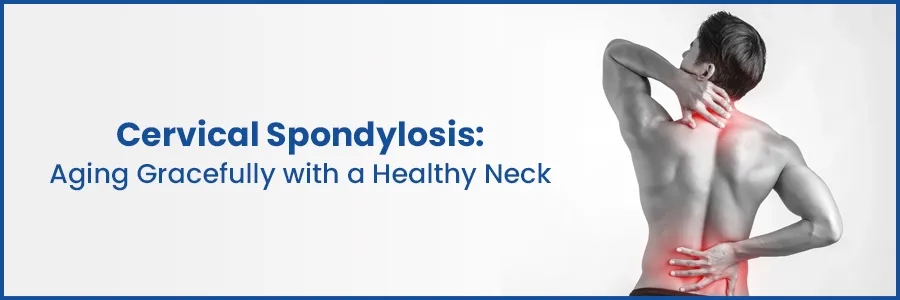- Cardiology 84
- Dermatology 45
- Endocrinology 33
- ENT 16
- Fertility 190
- Gastroenterology 78
- General-Medicine 81
- Gynecology 80
- Hematology 19
- Infectious-Diseases 33
- Neurology 52
- Oncology 34
- Ophthalmology 23
- Orthopedics 69
- Pediatrics 31
- Procedure 23
- Public-Health 144
- Pulmonology 59
- Radiology 8
- Urology 68
- Wellness 161
- Woman-and-child 77

Understanding Cervical Spondylosis
Cervical spondylosis is a common degenerative condition affecting the cervical spine (neck vertebrae and discs). It falls under the broader category of spondylosis, which refers to degenerative changes in the spine. It is distinct from ankylosing spondylosis, which involves stiffness or fusion of joints.
What is Cervical Spondylosis?
Cervical spondylosis, also known as osteoarthritis of the neck, is a natural part of aging. It can impact neck health and overall well-being. Understanding its symptoms, causes, and treatment options can help manage the condition effectively.
Cervical Spondylosis Symptoms
Symptoms can range from mild to severe and may affect daily activities:
- Neck Pain: Persistent discomfort, often worsened by movement or prolonged sitting.
- Stiffness: Reduced neck mobility and tightness, particularly after inactivity.
- Headaches: Pain extending from the neck to the head, leading to tension headaches.
- Numbness and Tingling: Nerve compression may cause sensations in the arms and hands.
Cervical Spondylosis Treatment
Management options include:
- Physical Therapy: Tailored exercises to strengthen neck muscles, improve flexibility, and reduce pain.
- Medications: Over-the-counter pain relievers, anti-inflammatory drugs, and muscle relaxants for temporary relief.
- Lifestyle Modifications: Maintaining a healthy weight, practicing good posture, and avoiding neck strain.
- Hot and Cold Therapy: Warm or cold packs to relieve pain and reduce inflammation.
- Supportive Devices: Special pillows and neck braces for support and alignment.
- Injections: Corticosteroid injections to reduce inflammation and pain.
Ready to take control of your health journey? Book your appointment now and start your path towards wellness today!
Book an AppointmentEmbracing a Healthy Neck as We Age
- Maintain Proper Posture: Correct posture during sitting, standing, and walking to reduce stress on the neck.
- Stay Active: Regular exercise, including neck stretches, yoga, or swimming, to maintain flexibility and strength.
- Ergonomic Workspace: Set up your workstation ergonomically to support a neutral spine position and prevent neck strain.
- Stay Hydrated: Drink plenty of water to support the health of intervertebral discs and maintain their elasticity.
- Nutrition Matters: A balanced diet with calcium, vitamin D, and omega-3 fatty acids for bone and joint health.
- Mind Your Sleeping Habits: Use a supportive pillow and mattress, and sleep on your back or side to maintain a neutral neck position.
- Avoid Excessive Strain: Avoid heavy loads on the head or shoulders and be mindful of neck position during activities.
- Regular Exercise: Engage in neck and upper back exercises, and consult a medical expert for tailored routines.
At Medicover Hospitals, our Orthopedic and Neurology specialists offer advanced diagnostics and personalized treatments to support your cervical spondylosis journey. Embrace a healthy aging process with expert care and compassion.
Conclusion
Cervical spondylosis is a natural part of aging but doesn't have to diminish quality of life. Understanding symptoms, seeking appropriate treatment, and adopting healthy habits can help maintain neck health and support a resilient, active life.
Frequently Asked Questions
While it's a natural part of aging, adopting healthy habits like good posture, staying active, doing neck exercises, and ensuring ergonomic setups can reduce its risk.
Treatments include physical therapy, pain relief medications, lifestyle adjustments, hot/cold therapy, and sometimes corticosteroid injections. Surgery is considered if conservative treatments don't work.
If neck pain, stiffness, or related symptoms persist and affect daily life, consulting an orthopedic specialist or neurologist for diagnosis and treatment recommendations is advisable.
Poor posture can worsen cervical spondylosis by straining the neck. Good posture helps distribute spine weight evenly, supporting neck health and overall spine wellness.
Yes, supervised yoga can aid by enhancing neck flexibility, strengthening supporting muscles, and easing discomfort. It's crucial to practice under expert guidance to avoid worsening the condition.
A balanced diet rich in calcium, vitamin D, and omega-3 fatty acids supports bone and joint health, benefiting the cervical spine. Include dairy, leafy greens, fatty fish, and nuts for overall well-being.
Aging well with a healthy neck involves staying active, maintaining good posture, seeking medical advice as needed, and integrating neck-strengthening exercises. Prioritize self-care and informed choices for neck health as part of your aging journey.

- Cardiology 2132
- Dermatology 168
- Endocrinology 135
- ENT 97
- Fertility 217
- Gastroenterology 232
- General 478
- General-Medicine 1685
- Gynecology 169
- Hematology 85
- Infectious-Diseases 208
- Neurology 207
- Oncology 345
- Ophthalmology 65
- Orthopedics 187
- Pediatrics 83
- Procedure 72
- Public-Health 209
- Pulmonology 126
- Radiology 13
- Second Opinion 311
- Urology 294
- Wellness 600
- Woman-and-child 447
- Others 10217
Related Blogs
If you have any questions, please fill out the enquiry form or call us, and we will get back to you promptly.
040-68334455